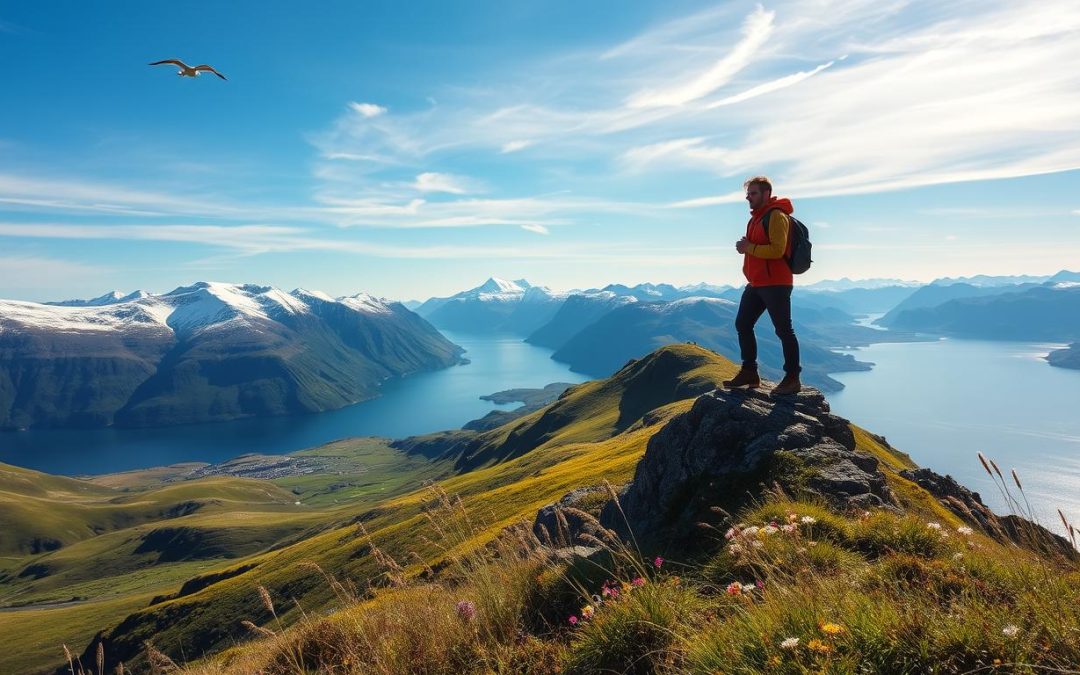Ever wondered how to plan your trip around the perfect weather? Norway’s unique climate offers something special every time of the year. Whether you’re chasing the midnight sun or the northern lights, understanding the weather is key to an unforgettable experience.
Thanks to the Gulf Stream, even northern parts of the country enjoy milder temperatures than you’d expect. This makes Norway a year-round destination. Summers bring long, bright days, while winters enchant with snowy landscapes and dancing auroras.
Your travel plans can vary greatly depending on the time of year. From June’s endless daylight to the cozy charm of winter nights, each season has its own way of captivating visitors. This guide will help you choose the best time to explore this stunning country.
Key Takeaways
- Norway’s climate is influenced by the Gulf Stream, making it milder than expected.
- Summer offers long days and warm weather, ideal for outdoor activities.
- Winter is perfect for viewing the northern lights and enjoying snow sports.
- Each season provides unique experiences, from festivals to serene landscapes.
- Plan your trip based on the weather to make the most of your visit.
Understanding Norway’s Climate and Seasonal Variations
Understanding the weather patterns in this Scandinavian country can transform your travel experience. From the mild coastal breezes to the frosty inland winters, the climate here is as diverse as its landscapes. Whether you’re planning a summer hike or a winter aurora chase, knowing what to expect can make all the difference.
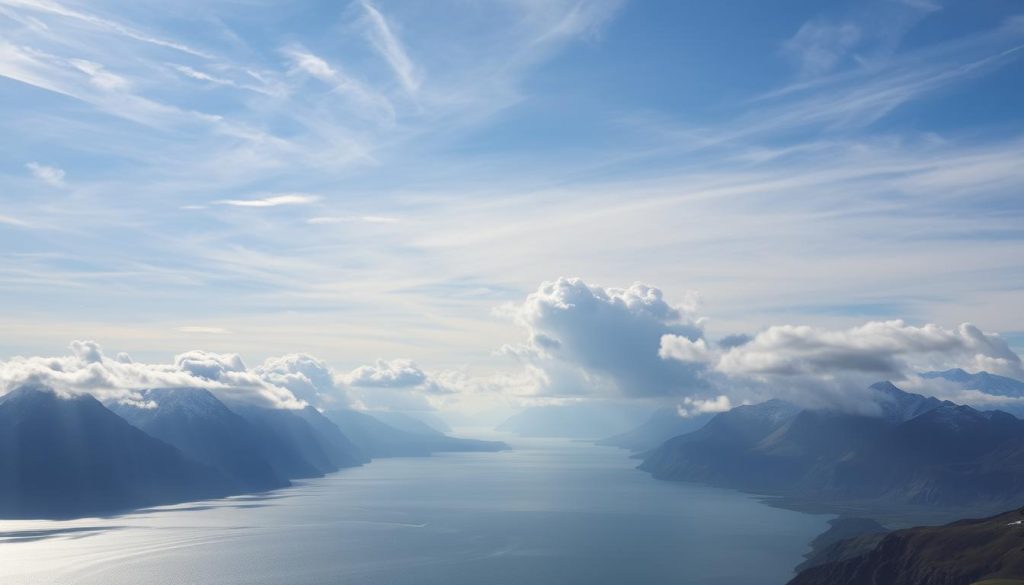
Coastal vs. Inland Weather Patterns
Coastal areas, like Bergen, enjoy milder winters thanks to the Gulf Stream. Summers here are cooler, with temperatures rarely exceeding 80°F (27°C). In contrast, inland cities such as Oslo experience more extreme shifts. Winters can drop to -13°F (-25°C), while summers may reach the mid-80s°F (30°C).
Rainfall also varies significantly. Bergen averages over 85 inches of rain annually, while Oslo receives around 30 inches. These differences highlight the importance of packing for your specific destination.
Daylight Changes and Seasonal Extremes
Daylight in Norway shifts dramatically throughout the year. In winter, southern regions may only see five to six hours of light per day. Meanwhile, the polar nights in the north mean weeks of darkness. Conversely, summer brings the midnight sun, where the sun never fully sets in June and July.
These extremes influence travel plans. Winter is ideal for northern lights viewing, while summer offers endless daylight for outdoor adventures. Understanding these patterns ensures you make the most of your time in this stunning country.
Norway: Best Months for a Weather-Savvy Trip
Planning your visit to this Nordic gem? Timing is everything. The right season can transform your experience, whether you’re chasing sunny days or the magical northern lights. Let’s dive into the details to help you plan the perfect trip.
Optimal Weather from May to September
From May to September, the weather is at its most pleasant. Temperatures range from 50°F to 70°F (10°C to 21°C), making it ideal for outdoor activities. Longer daylight hours mean more time to explore fjords, hike scenic trails, or stroll through charming towns.
Summer is the peak season for tourists, and for good reason. The mild climate allows you to enjoy everything from kayaking to sightseeing without the chill of winter. Pack light layers and prepare for unforgettable adventures.
When to Embrace the Northern Lights
If your goal is to witness the northern lights, plan your trip between October and March. During these months, the nights are long and dark, creating the perfect backdrop for this natural phenomenon. Temperatures can drop to -13°F (-25°C), so bundle up!
Popular viewing spots like Tromsø and Lofoten offer minimal light pollution, enhancing your chances of a spectacular display. Clear skies are essential, so check the weather forecast before heading out.
Whether you’re drawn to the warmth of summer or the magic of winter, choosing the right month ensures a memorable experience. Pack accordingly, and get ready to explore this breathtaking destination.
Exploring City-Specific Weather: Oslo, Bergen, Trondheim, and Tromsø
Each city in this Nordic country has its own weather personality. From mild winters in Oslo to the rainy charm of Bergen, understanding these differences can help you plan your trip better. Whether you’re chasing the northern lights or exploring fjords, knowing what to expect ensures a smoother experience.
Experience Oslo’s Mild Winters and Warm Summers
Oslo’s climate is shaped by its oceanic influence, making winters milder than other inland areas. Temperatures rarely drop below -4°C, even in January. Summers are warm, with July averaging 22°C, perfect for outdoor activities like hiking or visiting the Vigeland Sculpture Park.
With 1,600 hours of sunshine annually, Oslo is a great destination year-round. Pack layers for winter and light clothing for summer to enjoy everything this vibrant city offers.
Bergen’s Rainy Charm and Coastal Influence
Bergen is known for its rainfall, averaging 2,250 mm annually. Despite the rain, the city’s coastal location keeps temperatures moderate, rarely exceeding 20°C in summer. Winter temperatures hover around 0°C, making it a cozy destination for exploring Bryggen Wharf or the Fløibanen Funicular.
If you’re visiting, bring a waterproof jacket and embrace the city’s unique charm. The rain only adds to its picturesque landscapes.
Trondheim and Tromsø: Balancing Snow and Scenic Wonders
Trondheim offers a mix of snowy winters and mild summers. January temperatures average -6°C, while July sees highs of 20°C. The city’s historic Nidaros Cathedral and scenic river views are must-sees, regardless of the season.
Tromsø, on the other hand, is a winter wonderland. With average snowfall of 3,000 mm annually, it’s a prime spot for northern lights viewing. Summer brings the midnight sun, offering 24 hours of daylight in June.
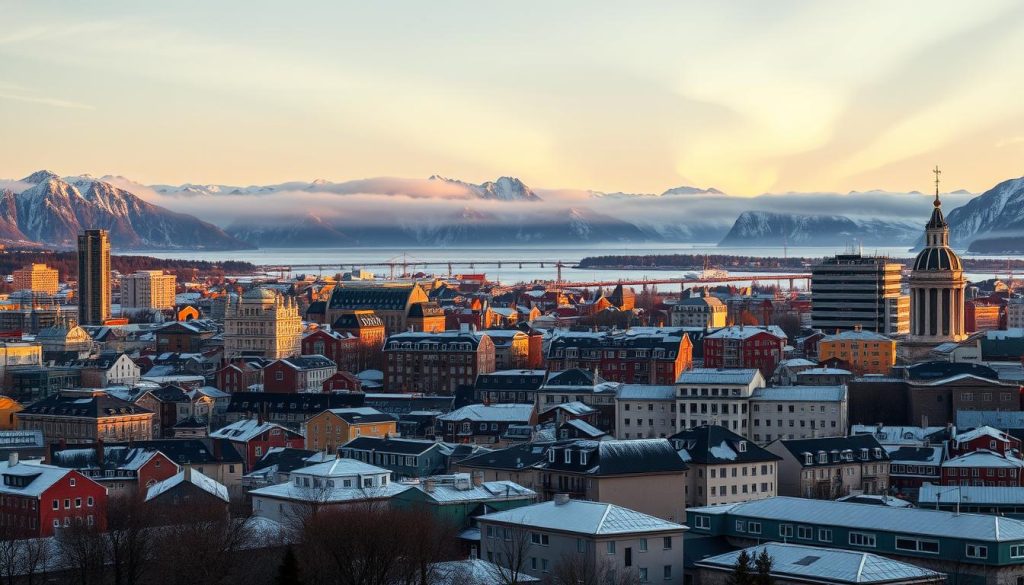
“The weather in each city tells a story, shaping the culture and activities you’ll find there.”
| City | Winter Temperature | Summer Temperature | Annual Rainfall/Snowfall |
|---|---|---|---|
| Oslo | -4°C | 22°C | 150 cm snowfall |
| Bergen | 0°C | 20°C | 2,250 mm rainfall |
| Trondheim | -6°C | 20°C | 140 cm snowfall |
| Tromsø | -4°C | 11°C | 3,000 cm snowfall |
Understanding these city-specific weather patterns can refine your travel plans. Whether you’re drawn to Oslo’s museums, Bergen’s fjords, or Tromsø’s northern lights, each destination offers something unique. Pack accordingly and get ready to explore!
Practical Travel Tips for a Weather-Savvy Trip to Norway
Packing smart and planning ahead can make your trip to this stunning country even more enjoyable. Whether you’re exploring fjords or wandering through charming cities, being prepared for the weather ensures you can focus on the experience.
Packing Essentials for Every Season
Layering is key when packing for this destination. In spring, bring warm layers and a waterproof jacket, as snow may still linger in some areas. Summer calls for lighter clothing during the day, but a light sweatshirt is handy for cooler evenings.
Winter demands thick layers and waterproof windbreakers, especially for outdoor activities like dog sledding or glacier walks. Don’t forget sturdy walking shoes, scarves, and hats to stay comfortable in fluctuating temperatures.
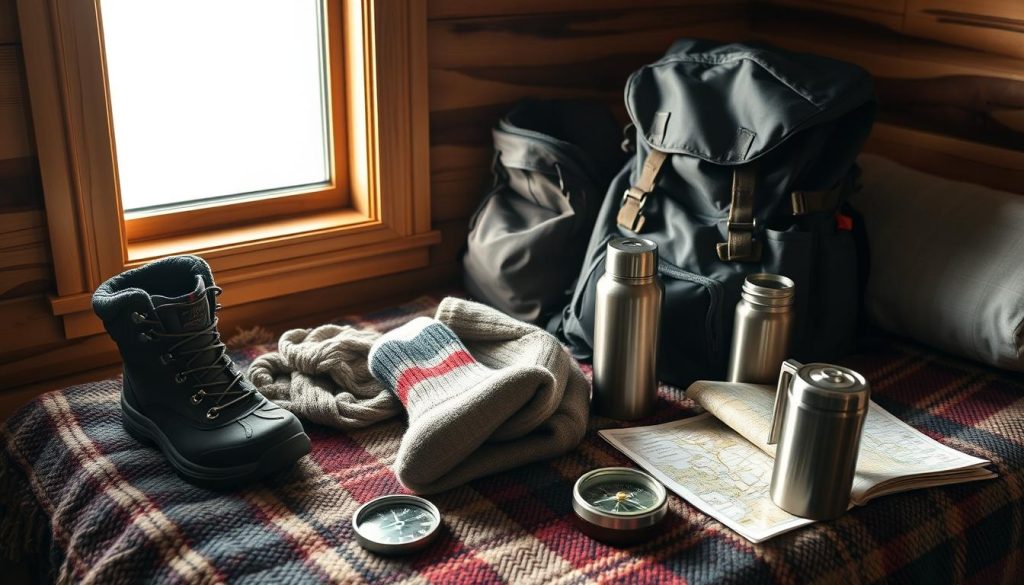
Balancing packing light with being prepared is crucial. Focus on versatile items that can adapt to changing conditions. This way, you’ll be ready for anything the weather throws your way.
Outdoor Activities and Local Attractions
This country offers a wide range of activities, no matter the season. In summer, hike scenic fjords or kayak through crystal-clear waters. Winter is perfect for chasing the northern lights or enjoying snow sports like skiing and snowshoeing.
If you’re visiting cities like Oslo or Bergen, take time to explore museums and historic sites. These indoor attractions are great for cooler or rainy days. Each season brings unique experiences, so plan your itinerary accordingly.
Being prepared with the right gear and a flexible mindset will enhance your travel experience. Whether you’re hiking, sightseeing, or simply soaking in the views, you’ll be ready to make the most of your time in this breathtaking part of Europe.
Navigating Tourist Crowds and Off-Season Benefits
Looking for a more peaceful way to explore? Off-season travel might be your answer. While summer draws the most visitors, quieter months like September and October offer a chance to enjoy this stunning destination without the hustle and bustle. Lower crowds and competitive pricing make it an appealing option for those seeking a more relaxed experience.
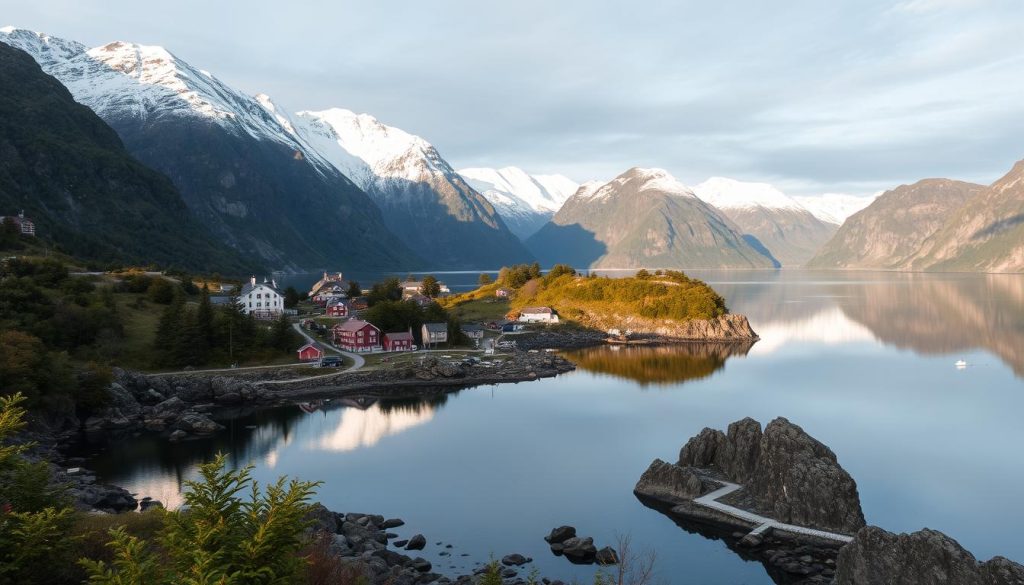
Finding Quiet Moments Outside Peak Seasons
Traveling during off-peak months doesn’t mean missing out. In fact, it often leads to a more personalized trip. With fewer tourists, you can take your time exploring iconic spots like Oslo’s museums or Bergen’s fjords. The cooler temperatures and shorter daylight hours create a cozy atmosphere, perfect for reflective outdoor activities.
One of the biggest perks of off-season travel is the cost savings. Flights and accommodations are often more affordable, allowing you to stretch your budget further. Plus, you’ll have more flexibility in planning your itinerary, as attractions and tours are less likely to be fully booked.
“Off-season travel lets you connect with a place on a deeper level, away from the crowds.”
Even in cooler months, the weather supports plenty of adventures. Hiking trails in the mountains remain accessible, and the crisp air adds a refreshing touch to your outdoor activities. If you’re visiting cities like Oslo or Bergen, you’ll find cultural events and local festivals that highlight the charm of the season.
To make the most of shorter daylight hours, plan your days strategically. Start early to maximize your time outdoors, and save indoor activities for the afternoon or evening. Flexibility is key, as weather conditions can change quickly. Embrace the unpredictability, and you’ll discover a side of this destination that’s just as captivating as its summer counterpart.
Whether you’re drawn to the serene fjords or the vibrant city life, off-season travel offers a unique way to experience this breathtaking part of the world. Pack your layers, plan with flexibility, and get ready to enjoy a quieter, more intimate adventure.
Conclusion
From sunny summer days to snowy winter nights, this destination offers something special for every traveler. Whether you’re exploring the vibrant streets of Oslo or chasing the northern lights in Bergen, understanding the weather and seasonal patterns is key to a memorable trip.
Each city has its own charm, from mild coastal breezes to crisp inland winters. Plan your visit around the activities you love—hiking in summer or skiing in winter. With the right preparation, you’ll make the most of every day.
Ready to start your adventure? Use this guide to tailor your trip and embrace the unique magic of every season. Pack smart, plan ahead, and get ready to explore this breathtaking destination with confidence!
The above is subject to change.
Check back often to TRAVEL.COM for the latest travel tips and deals.
Here are some Tours & Sightseeing suggestions that might pique your interests!
